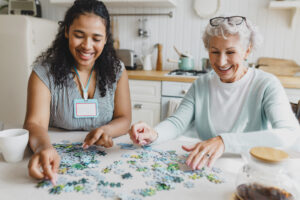When my grandmother started losing her vision, it didn’t go all at once. At first, it was just hazy spots in front of her eyes. Then, things started getting dimmer, and she had trouble maneuvering around the house. Finally, she could see little more than shadows, and was eventually declared legally blind.
Needless to say, senior vision loss like this is a serious matter. In addition to the emotional and psychological implications,[1. “Emotional adjustment to vision loss,” https://www.visionaware.org/info/emotional-support/1] steps must be taken to ensure that the patient doesn’t come to harm from their condition. This probably means making changes in their home, as well as learning about devices that can make everyday life easier.
Why Does Your Loved One Have Vision Loss?
Almost 3.5 million Americans over 40 suffer vision loss, with age-related conditions being the most common culprit. There are also a number of more acute causes, such as strokes, TBI’s (Traumatic Brain Injuries), and brain tumors. Age-related vision loss itself is generally due to one or more of these conditions: macular degeneration, glaucoma, cataracts, and diabetic retinopathy.
Adapting to Vision Loss at Home
The following are changes you may want to make in order to keep your loved one with low vision safe in their home:
Let there be light
One of the first things you’ll want to do to help your loved one adapt to low vision is to change the lighting. Putting in additional lamps and bulbs (including night lights and stair lights) is often a good first step. But there’s one type of light that you don’t want to increase: glare. Glare makes it harder to see, and should be reduced whenever possible. To this end, put up blinds or shades that can be closed when the sun is too bright, or consider anti-glare sunglasses or visors when your loved is outside.
Create contrast
Contrasting dark and light colors throughout the home can be helpful too. Try light-colored bathroom towels, dishware, utensils, and handrails against a dark background, or vice versa.
Get organized
Give everything in the home a “home” of its own, so your loved one always knows where to look for it. For instance, always keep the remote on the far right side of the coffee table, the water pitcher on the counter next to the sink, et cetera.
Make your mark
Use a thick black pen and masking tape (or sticky labels) to mark important items in the home. These can include stove dials, medications, and on/off buttons for various pieces of equipment.
Assistive Devices for Those with Low Vision
Adapting to vision loss isn’t just a matter of altering the patient’s living space.[2. “Vision loss – adapting to life with vision impairment,” https://www.betterhealth.vic.gov.au/bhcv2/bhcPDF.nsf/byPDF/Vision_loss_adapting_to_life_with_vision_impairement/$File/Vision_loss_adapting_to_life_with_vision_impairement.pdf] Below is a list of items that may help your loved one perform everyday activities:
- Magnifying glasses. To aid in reading everything from newspapers to bills, magnifying glasses come in many different shapes and sizes.
- CCTV’s (closed circuit televisions). CCTV’s have a computer-like screen at eye level that magnifies what the user does on a desktop. These instruments can let those with low vision continue to write letters, checks, or just read a book without a hand-held magnifier.
- Large button telephones. Phones with larger buttons can display numbers big enough for your loved one to see clearly, and use the phone independently.
Help Your Loved One Adapt to Senior Vision Loss Today
Senior vision loss is just like any other home safety issue: it needs to be dealt with swiftly and effectively. Not taking the proper precautions puts your loved one in just as much danger as leaving the front door unlocked or the stove on. However, by following the advice outlined above, you can help them function at their best – and safest – for a long time to come.
If you are unsure of how to best help an aging loved one, the trained and compassionate staff at the Institute on Aging is here to help you make that decision and gain the best in at-home care for older adults. Contact us to find out more.







